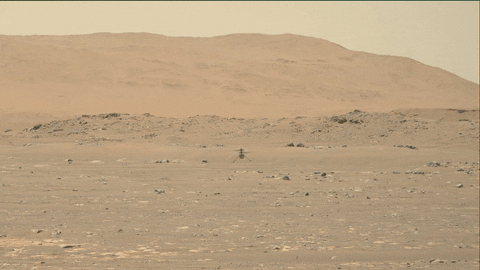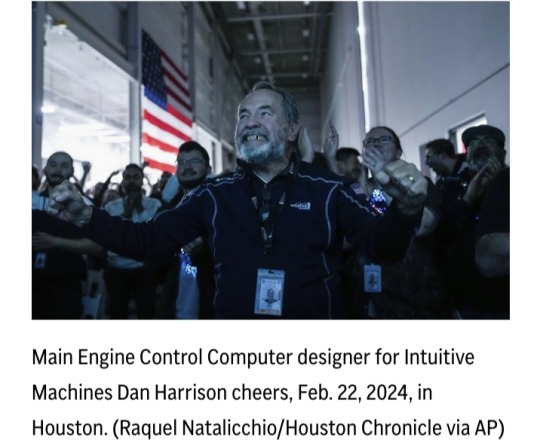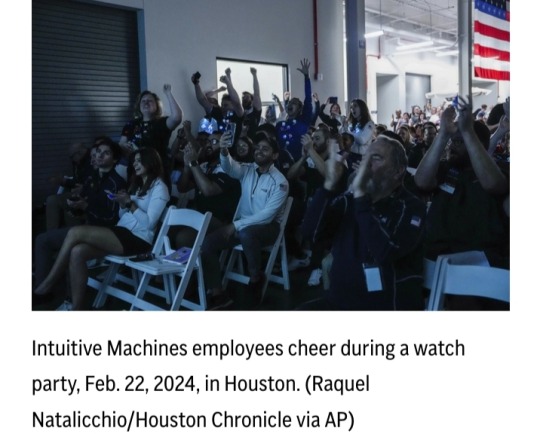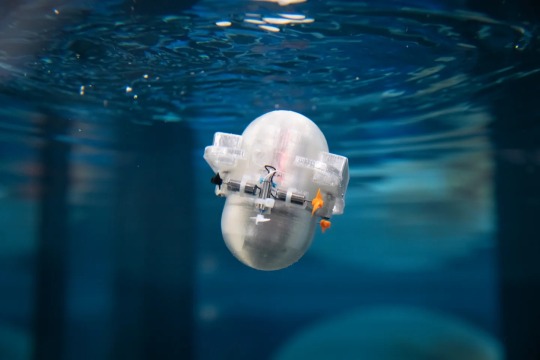#Autonomous Commercial Vehicles
Text
Driving the Future: Autonomous Commercial Vehicle Market Revolution
The autonomous commercial vehicle market is experiencing growth and is projected to reach USD 1,302.1 billion by 2030. This development can be ascribed to the continuing development in commercial vehicle technologies, growing government aid for autonomous commercial cars, and rising requirement for effective advantages and well-organized and safer driving options.

In recent years, the semi-autonomous category, on the basis of vehicle autonomy, contributed a higher revenue share. Vehicles must be fortified with electronic stability control or at least one of the progressive driver-assistance system ADAS features (either for steering or acceleration) to attain level 1 automation. Most of the European nations and the U.S. have forced the acceptance of basic ADAS features in all new commercial vehicles, which essentially makes all of them semi-autonomous.
In recent years, the truck category held the larger market share, and the category is projected to remain dominant in the vehicle type segment of the industry during the projection period. This can be credited to the growing utilization of autonomous trucks for logistical processes, like domestic logistics transportation, automated material handling, logistics digitalization, and yard management.
In the coming few years, on the basis of the application segment, the public transportation category is projected to advance at the fastest rate. This can be credited to the rising acceptance of autonomous shuttle facilities for public mobility reasons. Numerous start-ups and recognized businesses are coming up with strategies to grow level 5 autonomous shuttles for public transport. Such shuttles will not need human drivers for the process, which will aid transportation agencies save on working prices.
In the past few years, the North American region dominated the industry with the highest revenue for the autonomous commercial vehicle market, and the region is also projected to remain in the top spot during the projection period. This can be mainly credited to the increasing research and development activities on autonomous automobiles and growing aid from the federal and state governments for advancing autonomous driving technologies.
The APAC region is projected to witness the fastest development because of the booming vehicle industry here. APAC is the globe's largest vehicle maker, responsible for almost half of the annual production.
Hence, the continuing development in commercial vehicle technologies, growing government aid for autonomous commercial cars, and rising requirement for effective advantages are the major factors propelling the market.
#Autonomous Commercial Vehicles#Self-Driving Trucks#Logistics Automation#Transportation Industry#Freight Efficiency#Connectivity Solutions#Driverless Technology#Market Trends#Fleet Management#Autonomous Delivery#Truck Platooning#Market Players#Freight Transportation#Urban Mobility#Automation Innovation#Autonomous Trucking#Safety Systems#AI-driven Logistics#Long-Haul Trucking#Commercial Vehicle Automation
0 notes
Text

#future#history#electric vehicles#unusual vehicles#vehicle transport#autonomous vehicles#commercial vehicles#vehicles#ausgov#politas#auspol#tasgov#taspol#australia#fuck neoliberals#neoliberal capitalism#anthony albanese#albanese government#roads#road#space#earth#ecology#pollution#pollutants#polluted water#polluted air#safety#health#occupational health and safety
18 notes
·
View notes
Text
The Latest Breakthroughs in Technology for 2024
Introduction
Welcome to TechtoIO, your go-to source for the latest in tech news and trends. As we dive into 2024, the tech landscape continues to evolve at a rapid pace. From artificial intelligence advancements to breakthroughs in quantum computing, this year promises to be a landmark in technological innovation. In this comprehensive guide, we’ll explore the most exciting developments in technology for 2024, offering insights into how these advancements will impact our lives and industries. Read to continue
#Innovation Insights#Tags2024 tech innovations#5G technology 2024#AI in education 2024#AI in healthcare 2024#artificial intelligence advancements 2024#autonomous vehicles 2024#blockchain technology advancements 2024#commercial space flights 2024#CRISPR gene editing 2024#deep space missions 2024#edge computing 2024#electric vehicles 2024#industrial automation 2024#latest breakthroughs in technology 2024#quantum computing breakthroughs#renewable energy innovations 2024#solar power advancements#space exploration technology 2024#synthetic biology breakthroughs#wind energy technology 2024#Technology#Science#business tech#Adobe cloud#Trends#Nvidia Drive#Analysis#Tech news#Science updates
1 note
·
View note
Text
Rivian Introduces R2, R3, and R3X Built on New Midsize Platform
LAGUNA BEACH, Calif. March 7, 2024 – Rivian today unveiled its new midsize platform which underpins R2 and R3 product lines.
R2 is Rivian’s all-new midsize SUV delivering a combination of performance, capability and utility in a five-seat package optimized for big adventures and everyday use. The silhouette and face of R2 are distinctly Rivian. The powered rear glass fully drops into the…

View On WordPress
#acceleration#adventure#Adventure Gear#affordability#all-new platform#automotive engineering#Automotive Technology#autonomous capabilities#autonomous driving#battery#capital efficiency#cash visibility#commercial vehicles#consumer services#cost savings#crossover#design innovation#design language#direct sales#drive unit#Durability#electric mobility#electric vehicles#emission reduction#energy density#environmental preservation#fast charging#feature growth#global transition#haptic controls
0 notes
Text

Diamond Edge Limo provides a luxurious transportation in NJ, NY, TX, CA and PA. Elevate your travel experience with our luxurious fleet and professional chauffeurs. Our fleet includes Suv, Sedan, Sprinter limo, Strech limo and Limousine party bus.
visit at: https://diamondedgelimo.com
email at: [email protected]
call at: 1(888)568 9170
#limo rental#classic cars#airport limo service#limo service#sprinter van#electric vehicles#unusual vehicles#autonomous vehicles#commercial vehicles#vehicle service near me#cars#electric cars#fast cars#car show#suv#sedan#volvo#vehicle
1 note
·
View note
Text
0 notes
Text

What We Learned from Flying a Helicopter on Mars

The Ingenuity Mars Helicopter made history – not only as the first aircraft to perform powered, controlled flight on another world – but also for exceeding expectations, pushing the limits, and setting the stage for future NASA aerial exploration of other worlds.
Built as a technology demonstration designed to perform up to five experimental test flights over 30 days, Ingenuity performed flight operations from the Martian surface for almost three years. The helicopter ended its mission on Jan. 25, 2024, after sustaining damage to its rotor blades during its 72nd flight.
So, what did we learn from this small but mighty helicopter?
We can fly rotorcraft in the thin atmosphere of other planets.
Ingenuity proved that powered, controlled flight is possible on other worlds when it took to the Martian skies for the first time on April 19, 2021.
Flying on planets like Mars is no easy feat: The Red Planet has a significantly lower gravity – one-third that of Earth’s – and an extremely thin atmosphere, with only 1% the pressure at the surface compared to our planet. This means there are relatively few air molecules with which Ingenuity’s two 4-foot-wide (1.2-meter-wide) rotor blades can interact to achieve flight.
Ingenuity performed several flights dedicated to understanding key aerodynamic effects and how they interact with the structure and control system of the helicopter, providing us with a treasure-trove of data on how aircraft fly in the Martian atmosphere.
Now, we can use this knowledge to directly improve performance and reduce risk on future planetary aerial vehicles.

Creative solutions and “ingenuity” kept the helicopter flying longer than expected.
Over an extended mission that lasted for almost 1,000 Martian days (more than 33 times longer than originally planned), Ingenuity was upgraded with the ability to autonomously choose landing sites in treacherous terrain, dealt with a dead sensor, dusted itself off after dust storms, operated from 48 different airfields, performed three emergency landings, and survived a frigid Martian winter.
Fun fact: To keep costs low, the helicopter contained many off-the-shelf-commercial parts from the smartphone industry - parts that had never been tested in deep space. Those parts also surpassed expectations, proving durable throughout Ingenuity’s extended mission, and can inform future budget-conscious hardware solutions.

There is value in adding an aerial dimension to interplanetary surface missions.
Ingenuity traveled to Mars on the belly of the Perseverance rover, which served as the communications relay for Ingenuity and, therefore, was its constant companion. The helicopter also proved itself a helpful scout to the rover.
After its initial five flights in 2021, Ingenuity transitioned to an “operations demonstration,” serving as Perseverance’s eyes in the sky as it scouted science targets, potential rover routes, and inaccessible features, while also capturing stereo images for digital elevation maps.
Airborne assets like Ingenuity unlock a new dimension of exploration on Mars that we did not yet have – providing more pixels per meter of resolution for imaging than an orbiter and exploring locations a rover cannot reach.

Tech demos can pay off big time.
Ingenuity was flown as a technology demonstration payload on the Mars 2020 mission, and was a high risk, high reward, low-cost endeavor that paid off big. The data collected by the helicopter will be analyzed for years to come and will benefit future Mars and other planetary missions.
Just as the Sojourner rover led to the MER-class (Spirit and Opportunity) rovers, and the MSL-class (Curiosity and Perseverance) rovers, the team believes Ingenuity’s success will lead to future fleets of aircraft at Mars.
In general, NASA’s Technology Demonstration Missions test and advance new technologies, and then transition those capabilities to NASA missions, industry, and other government agencies. Chosen technologies are thoroughly ground- and flight-tested in relevant operating environments — reducing risks to future flight missions, gaining operational heritage and continuing NASA’s long history as a technological leader.
youtube
You can fall in love with robots on another planet.
Following in the tracks of beloved Martian rovers, the Ingenuity Mars Helicopter built up a worldwide fanbase. The Ingenuity team and public awaited every single flight with anticipation, awe, humor, and hope.
Check out #ThanksIngenuity on social media to see what’s been said about the helicopter’s accomplishments.
youtube
Learn more about Ingenuity’s accomplishments here. And make sure to follow us on Tumblr for your regular dose of space!
5K notes
·
View notes
Text
Helm.ai Raises $31 Million in Series C Funding Round for Autonomous Vehicle Softwar
Helm.ai Raises $31 Million in Series C Funding Round for Autonomous Vehicle Softwar
Helm.ai is a startup based in Menlo Park, California that is developing software for advanced driver assistance systems, autonomous driving, and robotics. The company recently raised $31 million in a Series C round, led by Freeman Group, pushing its valuation to $431 million.
The company has developed software that can understand sensor data as well as a human, using an unsupervised learning…

View On WordPress
#ACVC Partners#advanced driver assistance systems#Amplo#autonomous driving#autonomous vehicles#commercial partnerships#Freeman Group#funding#Goodyear Ventures#Helm.ai#Honda Motor Co.#neural networks#OEMs#R&D#Series C#software#Sungwoo Hitech#Tier 1 suppliers#unsupervised learning#valuation
1 note
·
View note
Text
Future Scope of Unmanned Aerial Vehicle Market Size Expects to See Significant Growth At CAGR 12.23% During Period 2020-2027 | Worth USD 25.13 Million
The globalunmanned aerial vehicle market is expected to gain momentum from the increasing advancements in the field of drones. They are capable of analyzing millions of images for enhancing the decision-making skills of the management in a wide range of industries.Fortune Business Insights™presented this information in a new report, titled, “Unmanned Aerial Vehicle Market Size, Share & COVID-19 Impact Analysis, By Class (Small UAVs, Tactical UAVs, and Strategic UAVs), By Technology (Remotely Operated, Semi-autonomous, and Fully-autonomous), By System (UAV Airframe, UAV Payloads, UAV Avionics, UAV Propulsion, and UAV Software), By Application (Military, Commercial and Recreational), and Regional Forecast, 2020-2027.” The report further states that the unmanned aerial vehicle (UAV) market size wasUSD 10.72 billionin 2019 and is projected to reachUSD 25.13 billionby 2027, exhibiting a CAGR of 12.23% during the forecast period.
Information Source:
Competitive Landscape-
Key Players Focus on Delivering Essentials via UAVs to Prevent Coronavirus Infection
The market is highly fragmented with the presence of a wide range of manufacturing companies all over the world. Some of them are presently focusing on delivering essentials through drones owing to the COVID-19 pandemic. The others are focusing on mergers and acquisitions with other local enterprises to strengthen their positions. Below are a couple of the latest industry developments:
June 2020: After Wing, a firm owned by Google parent Alphabet launched its new drone delivery service in Virginia, Kelly Passek became the first customer. She is a middle-school librarian who petitioned the company to deliver library books to help kids in reading and learning amidst the COVID-19 pandemic.
September 2019: Rafael Advanced Defense Systems, a defense company based in Israel, successfully acquired Aeronautics Limited worth USD 240 million. This would help the latter to combine its expertise in intelligence, surveillance and reconnaissance with Rafael’s large network in the U.S. market.
The outbreak of the COVID-19 pandemic has halted the operations of several companies. But, some of them have resumed their production processes by stringently following social distancing and low workforce measures. We will soon be able to overcome this situation with the discovery of a vaccine. Our report would provide detailed information about the effects of this pandemic on every market. You can gain business confidence by selecting the right strategy.
Drivers & Restraints-
Need to Avoid Physical Contact amidst COVID-19 to Skyrocket Demand
The effect of COVID-19 pandemic on the market is likely to remain moderate backed by the increasing usage of drones by the regulatory bodies worldwide to monitor public gatherings, thereby limiting direct physical contact. Antwork Inc., a China-based drone delivery company, for instance, provided medical supplies and reduced the involvement of humans by using drones. Also, in countries, such as the Netherlands, Belgium, Spain, India, China, Russia, and France, UAVs are extensively being used to spray disinfectants on government buildings, emergency hospitals, and public healthcare infrastructure. However, the strict government norms and laws regarding the usage of airspace to eliminate accidental damages may hamper the unmanned aerial vehicle market growth in the coming years.
Segment-
Commercial Segment to Grow Rapidly Backed by Investment by Companies to Develop Air Taxi
In terms of application, the market is fragmented into commercial, residential, and military. Out of these, the commercial segment generated 4.6% in terms of unmanned aerial vehicle market share in 2019. This growth is attributable to the increasing usage of UAVs in logistics, forest monitoring, crop monitoring, aerial mapping, and surveying. Besides, industry giants, such as Uber and DHL Logistics are investing hefty amounts of money to develop Air Taxi and innovating air transportation, respectively. These factors would also contribute to the growth of this segment.
Regional Analysis-
Increasing Usage of Drones in Military Applications to Spur Growth in North America
Geographically, in 2019, North America held USD 3.88 billion in terms of revenue. The region is anticipated to dominate during the forthcoming years owing to the rising usage of UAVs in several military applications. The U.S. houses a large number of renowned military UAVs manufacturers who are gaining a competitive edge by exporting their products to numerous countries worldwide.
Europe, on the other hand, is expected to grow moderately stoked by the high demand for navigation systems, avionics, software solutions, and cameras in the region. In Asia Pacific, the high demand for advanced warfare UAVs for tactical and strategic applications would affect the market growth positively in the near future. The major importers in this region are China, Pakistan, and India.
This Report Answers the Following Questions:
What are the market dynamics, drivers, and obstacles?
Which company will generate the largest revenue in the near future?
How will COVID-19 impact the sales of UAVs?
Which strategies are being adopted by companies to intensify competition?
#The global unmanned aerial vehicle market is expected to gain momentum from the increasing advancements in the field of drones. They are cap#titled#“Unmanned Aerial Vehicle Market Size#Share & COVID-19 Impact Analysis#By Class (Small UAVs#Tactical UAVs#and Strategic UAVs)#By Technology (Remotely Operated#Semi-autonomous#and Fully-autonomous)#By System (UAV Airframe#UAV Payloads#UAV Avionics#UAV Propulsion#and UAV Software)#By Application (Military#Commercial and Recreational)#and Regional Forecast#2020-2027.” The report further states that the unmanned aerial vehicle (UAV) market size was USD 10.72 billion in 2019 and is projected to#exhibiting a CAGR of 12.23% during the forecast period.#Information Source:#https://www.fortunebusinessinsights.com/industry-reports/unmanned-aerial-vehicle-uav-market-101603#Unmanned Aerial Vehicle Market
0 notes
Text

Have Researchers Found Amelia Earhart’s Long-Lost Plane?
A new sonar image shows an airplane-shaped object resting on the bottom of the Pacific Ocean, not far from where Earhart and her navigator, Fred Noonan, went missing in 1937.
On July 2, 1937, pioneering pilot Amelia Earhart vanished somewhere over the Pacific Ocean near the end of her historic around-the-world flight. For decades, her mysterious disappearance has perplexed explorers, who have spent millions of dollars trying to find her missing Lockheed 10-E Electra plane.
Now, a possible new clue has emerged in the case: A sonar image captured during an expedition last fall shows an airplane-shaped object sitting on the ocean floor, not far from where experts believe Earhart likely crashed, reports the Wall Street Journal’s Nidhi Subbaraman.
The blurred object is far from definitive proof, but Dorothy Cochrane, an aeronautics curator at the Smithsonian’s National Air and Space Museum, tells Smithsonian magazine it’s “an intriguing image” that warrants a second look.


The expedition was led by Tony Romeo, who is a former intelligence officer with the U.S. Air Force, a pilot and a commercial real estate investor from South Carolina. In 2021, he sold his real estate properties and spent $11 million to fund the trip, including buying high-tech equipment to aid in the search.
“This has been a story that’s always intrigued me, and all the things in my life kind of collided at the right moment,” Romeo tells Business Insider’s Katherine Tangalakis-Lippert and Rebecca Rommen. “I was getting out of real estate and looking for a new project, so even though I really started about 18 months ago, this was something I’ve been thinking and researching for a long time.”
Last September, a team from the exploration company Deep Sea Vision, which Romeo founded, departed from Tarawa, Kiribati, in the South Pacific aboard a research vessel. Working in 36-hour shifts, the 16-person crew used an underwater autonomous vehicle equipped with sonar to scour the sea floor, scanning roughly 5,200 total square miles.
About 90 days into the trip, the team was reviewing sonar images and noticed something unusual in the data from some 60 days prior. The mysterious object looked to be about the same shape and size as an aircraft, and it was identified roughly 100 miles from Howland Island, which is within the region where experts think Earhart’s plane went down. The object is around 16,400 feet below the water’s surface.

By then, however, the crew had determined it was too late to return to the site for a closer look. The camera on the underwater vehicle was also broken, which meant they wouldn’t be able to see anything if they did circle back, reports the Post and Courier’s Tony Bartelme.
But Romeo is undeterred and hopes to revisit the area in the future.
“This is maybe the most exciting thing I’ll ever do in my life,” he tells the Wall Street Journal. “I feel like a 10-year-old going on a treasure hunt.”
In the meantime, the sonar image is not detailed enough for experts to draw any definitive conclusions.
“It definitely appears to be an aircraft of some sort,” David Jourdan, who has searched three times for Earhart’s missing plane and is the co-founder and president of the ocean exploration company Nauticos, tells the Post and Courier. “It has aircraft-like features. But sound is funny. It can mislead you. We can’t say it’s her plane until you put a camera on it.”
To truly identify the object, future missions would ideally capture detailed images that contain the registration number of the plane, says Cochrane. Or, at the very least, they might more clearly show the submerged object’s dimensions and shape to see if it matches the model of Earhart’s vehicle.

“It really requires further research,” says Cochrane. “Finding something that’s really worth investigating further is step one. Verifying it’s the actual craft is step two. And step three becomes: Is it possible to recover this or not, or should it just be left where it is?”
At the time of her disappearance, Earhart was a global celebrity—speaking with the Wall Street Journal, Romeo likens her to Taylor Swift today. In June 1928, Earhart became the first woman to fly across the Atlantic Ocean (as a passenger of pilots Wilmer Stultz and Lou Gordon), a feat that propelled her to international stardom.
Nearly four years later, in May 1932, she made history again by becoming the first woman to fly solo across the Atlantic Ocean. Later that year, she became the first woman to fly solo across North America and back. And in 1935, she became the first person, regardless of gender, to fly solo from Honolulu, Hawaii, to Oakland, California.
In the summer of 1936, the renowned pilot began to plan her most ambitious trip yet: a circumnavigation of the globe. On May 20, 1937, Earhart and her navigator, Fred Noonan, departed from Oakland for the first leg of the trip. They flew nearly 22,000 miles, making stops in Miami, South America, Africa and India along their eastward route.



By late June, they had made it to Lae, Papua New Guinea. After a few days’ rest, they departed for Howland Island, a small, uninhabited outcrop in the Pacific where a refueling station had been built for their journey. The U.S. Coast Guard had a vessel, the Itasca, stationed nearby to help with the landing.
Operators aboard the Itasca heard Earhart’s radio messages as she got closer and closer to the island. But eventually, they lost contact. Earhart and Noonan were never seen or heard from again.
The U.S. Navy and Coast Guard spent 16 days searching for the missing duo without success. About one and a half years later, on January 5, 1939, Earhart was declared dead.
Theories abound about her mysterious disappearance—some onlookers have speculated that she was a spy or that she was captured by a foreign military. But Cochrane believes the simplest explanation is the most plausible: that Earhart and Noonan ran out of fuel near Howland Island.
“She’s got to be around there somewhere,” she adds.
By Sarah Kuta.

#Amelia Earhart#Have Researchers Found Amelia Earhart’s Long-Lost Plane?#Fred Noonan#Howland Island#Lockheed 10-E Electra plane#mystery#history#history news#long post#long reads
47 notes
·
View notes
Text
assuaging my anxieties about machine learning over the last week, I learn that despite there being about ten years of doom-saying about the full automation of radiomics, there's actually a shortage of radiologists now (and, also, the machine learning algorithms that are supposed to be able to detect cancers better than human doctors are very often giving overconfident predictions). truck driving was supposed to be completely automated by now, but my grampa is still truckin' and will probably get to retire as a trucker. companies like GM are now throwing decreasing amounts of money at autonomous vehicle research after throwing billions at cars that can just barely ferry people around san francisco (and sometimes still fails), the most mapped and trained upon set of roads in the world. (imagine the cost to train these things for a city with dilapidated infrastructure, where the lines in the road have faded away, like, say, Shreveport, LA).
we now have transformer-based models that are able to provide contextually relevant responses, but the responses are often wrong, and often in subtle ways that require expertise to needle out. the possibility of giving a wrong response is always there - it's a stochastic next-word prediction algorithm based on statistical inferences gleaned from the training data, with no innate understanding of the symbols its producing. image generators are questionably legal (at least the way they were trained and how that effects the output of essentially copyrighted material). graphic designers, rather than being replaced by them, are already using them as a tool, and I've already seen local designers do this (which I find cheap and ugly - one taco place hired a local designer to make a graphic for them - the tacos looked like taco bell's, not the actual restaurant's, and you could see artefacts from the generation process everywhere). for the most part, what they produce is visually ugly and requires extensive touchups - if the model even gives you an output you can edit. the role of the designer as designer is still there - they are still the arbiter of good taste, and the value of a graphic designer is still based on whether or not they have a well developed aesthetic taste themself.
for the most part, everything is in tech demo phase, and this is after getting trained on nearly the sum total of available human produced data, which is already a problem for generalized performance. while a lot of these systems perform well on older, flawed, benchmarks, newer benchmarks show that these systems (including GPT-4 with plugins) consistently fail to compete with humans equipped with everyday knowledge.
there is also a huge problem with the benchmarks typically used to measure progress in machine learning that impact their real world use (and tell us we should probably be more cautious because the human use of these tools is bound to be reckless given the hype they've received). back to radiomics, some machine learning models barely generalize at all, and only perform slightly better than chance at identifying pneumonia in pediatric cases when it's exposed to external datasets (external to the hospital where the data it was trained on came from). other issues, like data leakage, make popular benchmarks often an overoptimistic measure of success.
very few researchers in machine learning are recognizing these limits. that probably has to do with the academic and commercial incentives towards publishing overconfident results. many papers are not even in principle reproducible, because the code, training data, etc., is simply not provided. "publish or perish", the bias journals have towards positive results, and the desire of tech companies to get continued funding while "AI" is the hot buzzword, all combined this year for the perfect storm of techno-hype.
which is not to say that machine learning is useless. their use as glorified statistical methods has been a boon for scientists, when those scientists understand what's going on under the hood. in a medical context, tempered use of machine learning has definitely saved lives already. some programmers swear that copilot has made them marginally more productive, by autocompleting sometimes tedious boilerplate code (although, hey, we've had code generators doing this for several decades). it's probably marginally faster to ask a service "how do I reverse a string" than to look through the docs (although, if you had read the docs to begin with would you even need to take the risk of the service getting it wrong?) people have a lot of fun with the image generators, because one-off memes don't require high quality aesthetics to get a chuckle before the user scrolls away (only psychopaths like me look at these images for artefacts). doctors will continue to use statistical tools in the wider machine learning tool set to augment their provision of care, if these were designed and implemented carefully, with a mind to their limitations.
anyway, i hope posting this will assuage my anxieties for another quarter at least.
35 notes
·
View notes
Text


The United States has returned to the lunar surface for the first time in more than 50 years after a privately-built spacecraft named Odysseus capped a nail-biting 73-minute descent from orbit with a touchdown near the moon’s south pole.
Amid celebrations of what NASA hailed “a giant leap forward,” there was no immediate confirmation of the status or condition of the lander, other than it had reached its planned landing site at crater Malapert A.
But later Intuitive Machines, the Texas-based company that built the first commercial craft to land on the moon, said the craft was “upright and starting to send data.”
The statement on X said mission managers were “working to downlink the first images from the lunar surface.”
The so-called “soft landing” on Thursday, which Steve Altemus, the company’s founder, had given only an 80% chance of succeeding, was designed to open a new era of lunar exploration as NASA works towards a scheduled late-2026 mission to send humans back there.
“Welcome to the moon,” Altemus said when touchdown when the 5.23pm touchdown was eventually confirmed, after about 10 minutes in which Odysseus was out of contact.
It was the first time any US-built spacecraft had landed on the moon since NASA’s most recent crewed visit, the Apollo 17 mission in December 1972, and the first visit by commercial vehicle following last month’s failure of Peregrine One, another partnership between the space agency and a private company, Astrobotic.

“Today, for the first time in more than a half century, the US has returned to the moon. Today, for the first time in the history of humanity, a commercial company, an American company, launched and led the voyage up there,” Bill Nelson, the NASA administrator, said.
“What a triumph. Odysseus has taken the moon. This feat is a giant leap forward for all of humanity.”
There was no video of Odysseus’s fully autonomous descent, which slowed to about 2.2mph at 33ft above the surface.
But a camera built by students at Florida’s Embry-Riddle Aeronautical University was designed to fall and take pictures immediately before touchdown, and NASA cameras were set to photograph the ground from the spacecraft.
The 14ft (4.3 metres) hexagonal, six-legged Nova-C lander, affectionately nicknamed Odie by Intuitive Machines employees, is part of NASA’s commercial lunar payload services (CLPS) initiative in which the agency awards contracts to private partners, largely to support the Artemis program.
NASA contributed $118m to get it off the ground, with Intuitive Machines funding a further $130m ahead of its February 15 launch from Florida’s Kennedy Space Center on a Falcon 9 rocket from Elon Musk’s SpaceX company.

The IM-1 mission, like the doomed Peregrine effort, is carrying a payload of scientific equipment designed to gather data about the lunar environment, specifically in the rocky region chosen as the landing site for NASA’s crewed Artemis III mission planned for two years’ time.
It is a hazardous area – “pockmarked with all of these craters,” according to Nelson – but chosen because it is believed to be rich in frozen water that could help sustain a permanent lunar base crucial to future human missions to Mars.
Scientists announced last year that they believed tiny glass beads strewn across the moon’s surface contained potentially “billions of tonnes of water” that could be extracted and used on future missions.
The risks are worth it, Nelson told CNN on Thursday, “to see if there is water in abundance. Because if there’s water, there’s rocket fuel: hydrogen, and oxygen. And we could have a gas station on the south pole of the moon.”
The planned operational life of the solar powered lander is only seven days, before the landing site about 186 miles from the moon’s south pole moves into Earth’s shadow.
But NASA hopes that will be long enough for analysis of how soil there reacted to the impact of the landing.
Other instruments will focus on space weather effects on the lunar surface, while a network of markers for communication and navigation will be deployed.
“Odysseus, powered by a company called Intuitive Machines, launched upon a SpaceX rocket, carrying a bounty of NASA scientific instruments, is bearing the dream of a new adventure in science, innovation, and American leadership in space,” Nelson said.


Through Artemis, NASA’s return-to-the-moon program that also has longer-term visions of crewed missions to Mars within the next two decades, the US seeks to stay ahead of Russia and China, both of which are planning their own human lunar landings.
Only the US has previously landed astronauts in six Apollo missions between 1969 and 1972, while five countries have placed uncrewed spacecraft there.
Japan joined the US, Russia, China, and India last month when its Smart Lander for Investigating the Moon (Slim) made a successful, if awkward touchdown after a three-month flight.
Two further Intuitive Machines launches are scheduled for later this year, including an ice drill to extract ingredients for rocket fuel, and another Nova-C lander containing a small Nasa rover and four small robots that will explore surface conditions.
https://www.theguardian.com/science/2024/feb/22/us-moon-landing-odysseus-intuitive-machines
youtube
US returns to lunar surface with for first time in over 50 years
23 February 2024
A spacecraft built and flown by Texas-based company Intuitive Machines landed near the south pole of the moon, the first US touchdown on the lunar surface in more than half a century, and the first ever achieved entirely by the private sector.
Communication with Odysseus seemed be lost during the final stages of the landing, leaving mission control uncertain as to the precise condition and position of the lander, according to flight controllers heard in the webcast.
US returns to lunar surface for first time in over 50 years: ‘Welcome to the moon.’
#Odysseus#Intuitive Machines#Youtube#NASA#Malapert A#moon#moon landing#spacecraft#Steve Altemus#lunar exploration#Bill Nelson#Nova-C lander#Odie#commercial lunar payload services (CLPS)#Artemis#Kennedy Space Center#Falcon 9#Elon Musk#SpaceX#IM-1 mission#Smart Lander for Investigating the Moon (SLIM)#lunar lander#earth
23 notes
·
View notes
Text
A 27-year-old who owns a $4 million Bugatti Chiron Pur Sport Carbon claims his hypercar goes a mere 62 miles on a full tank of fuel - Luxurylaunches
https://luxurylaunches.com/transport/bugatti-chiron-pur-sport-carbon-range.php
#bugatti chiron#hypercars#fossil fuels#goon fuel#nightmare fuel#fueled by ramen#fuel#fast cars#classic cars#electric cars#luxury cars#cars#car#autonomous vehicles#vehicle transport#unusual vehicles#electric vehicles#vehiclemaintenance#vehicleshipping#commercial vehicles#vehicles#vehicle#ausgov#politas#auspol#tasgov#taspol#australia#fuck neoliberals#neoliberal capitalism
1 note
·
View note
Text

Known for their progressive environmental policies and nature-loving citizens, Nordic countries also produce what may seem a counterintuitive film genre: ecohorror, where distinctions between humans and nature are blurred in unsettling ways. From slashers to arthouse thrillers, transnational Nordic ecohorror films such as Antichrist (dir. Lars von Trier, 2009) and Midsommar (dir. Ari Aster, 2019) have garnered commercial and critical attention, revealing an undercurrent of ecophobia in Nordic culture that belies the region's reputation for environmental friendliness. In Menacing Environments, Benjamin Bigelow examines how ecohorror rings some of the same alarm bells that climate activists have sounded, suggesting that the proper response to the ongoing climate catastrophe is not optimism and a market-friendly focus on sustainable development, but rather fear and dread. Bigelow argues that ecohorror destabilizes the two pillars of Nordic society—the autonomous individual and the sovereign state. He illustrates how doing away with any clean separation of the domains of human culture from a wild, untamed realm of nature reminds viewers of the complex and often threatening material entanglements between humans and their environments. Through Bigelow's analysis, ecohorror proves to be a potent vehicle not only for generating a strong affective response in audiences but also for taking on the revered institutions, unquestioned ideological orthodoxies, and claims of cultural exceptionalism in contemporary Nordic societies.
Menacing Environments - Ecohorror in Contemporary Nordic Cinema : Free Download, Borrow, and Streaming : Internet Archive
5 notes
·
View notes
Text
Aquatic Robot Market to Eyewitness Huge Growth by 2030

Latest business intelligence report released on Global Aquatic Robot Market, covers different industry elements and growth inclinations that helps in predicting market forecast. The report allows complete assessment of current and future scenario scaling top to bottom investigation about the market size, % share of key and emerging segment, major development, and technological advancements. Also, the statistical survey elaborates detailed commentary on changing market dynamics that includes market growth drivers, roadblocks and challenges, future opportunities, and influencing trends to better understand Aquatic Robot market outlook.
List of Key Players Profiled in the study includes market overview, business strategies, financials, Development activities, Market Share and SWOT analysis:
Atlas Maridan ApS. (Germany), Deep Ocean Engineering Inc. (United States), Bluefin Robotics Corporation (United States), ECA SA (France), International Submarine Engineering Ltd. (Canada), Inuktun Services Ltd. (Canada), Oceaneering International, Inc. (United States), Saab Seaeye (Sweden), Schilling Robotics, LLC (United States), Soil Machine Dynamics Ltd. (United Kingdom)
Download Free Sample PDF Brochure (Including Full TOC, Table & Figures) @ https://www.advancemarketanalytics.com/sample-report/177845-global-aquatic-robot-market
Brief Overview on Aquatic Robot:
Aquatic robots are those that can sail, submerge, or crawl through water. They can be controlled remotely or autonomously. These robots have been regularly utilized for seafloor exploration in recent years. This technology has shown to be advantageous because it gives enhanced data at a lower cost. Because underwater robots are meant to function in tough settings where divers' health and accessibility are jeopardized, continuous ocean surveillance is extended to them. Maritime safety, marine biology, and underwater archaeology all use aquatic robots. They also contribute significantly to the expansion of the offshore industry. Two important factors affecting the market growth are the increased usage of advanced robotics technology in the oil and gas industry, as well as increased spending in defense industries across various countries.
Key Market Trends:
Growth in AUV Segment
Opportunities:
Adoption of aquatic robots in military & defense
Increased investments in R&D activities
Market Growth Drivers:
Growth in adoption of automated technology in oil & gas industry
Rise in awareness of the availability of advanced imaging system
Challenges:
Required highly skilled professional for maintenance
Segmentation of the Global Aquatic Robot Market:
by Type (Remotely Operated Vehicle (ROV), Autonomous Underwater Vehicles (AUV)), Application (Defense & Security, Commercial Exploration, Scientific Research, Others)
Purchase this Report now by availing up to 10% Discount on various License Type along with free consultation. Limited period offer.
Share your budget and Get Exclusive Discount @: https://www.advancemarketanalytics.com/request-discount/177845-global-aquatic-robot-market
Geographically, the following regions together with the listed national/local markets are fully investigated:
• APAC (Japan, China, South Korea, Australia, India, and Rest of APAC; Rest of APAC is further segmented into Malaysia, Singapore, Indonesia, Thailand, New Zealand, Vietnam, and Sri Lanka)
• Europe (Germany, UK, France, Spain, Italy, Russia, Rest of Europe; Rest of Europe is further segmented into Belgium, Denmark, Austria, Norway, Sweden, The Netherlands, Poland, Czech Republic, Slovakia, Hungary, and Romania)
• North America (U.S., Canada, and Mexico)
• South America (Brazil, Chile, Argentina, Rest of South America)
• MEA (Saudi Arabia, UAE, South Africa)Furthermore, the years considered for the study are as follows:
Historical data – 2017-2022
The base year for estimation – 2022
Estimated Year – 2023
Forecast period** – 2023 to 2028 [** unless otherwise stated]
Browse Full in-depth TOC @: https://www.advancemarketanalytics.com/reports/177845-global-aquatic-robot-market
Summarized Extracts from TOC of Global Aquatic Robot Market Study Chapter 1: Exclusive Summary of the Aquatic Robot market
Chapter 2: Objective of Study and Research Scope the Aquatic Robot market
Chapter 3: Porters Five Forces, Supply/Value Chain, PESTEL analysis, Market Entropy, Patent/Trademark Analysis
Chapter 4: Market Segmentation by Type, End User and Region/Country 2016-2027
Chapter 5: Decision Framework
Chapter 6: Market Dynamics- Drivers, Trends and Challenges
Chapter 7: Competitive Landscape, Peer Group Analysis, BCG Matrix & Company Profile
Chapter 8: Appendix, Methodology and Data Source
Buy Full Copy Aquatic RobotMarket – 2021 Edition @ https://www.advancemarketanalytics.com/buy-now?format=1&report=177845
Contact US :
Craig Francis (PR & Marketing Manager)
AMA Research & Media LLP
Unit No. 429, Parsonage Road Edison, NJ
New Jersey USA – 08837
Phone: +1 201 565 3262, +44 161 818 8166
[email protected]
#Global Aquatic Robot Market#Aquatic Robot Market Demand#Aquatic Robot Market Trends#Aquatic Robot Market Analysis#Aquatic Robot Market Growth#Aquatic Robot Market Share#Aquatic Robot Market Forecast#Aquatic Robot Market Challenges
2 notes
·
View notes
Text
https://www.reuters.com/business/autos-transportation/tesla-lay-off-more-than-10-its-staff-electrek-reports-2024-04-15/
BERLIN, April 15 (Reuters) - Tesla (TSLA.O), opens new tab is laying off more than 10% of its global workforce, an internal memo seen by Reuters on Monday shows, as it grapples with falling sales and an intensifying price war for electric vehicles (EVs).
"About every five years, we need to reorganize and streamline the company for the next phase of growth," CEO Elon Musk commented in a post on X. Two senior leaders, battery development chief Drew Baglino and vice president for public policy Rohan Patel, also announced their departures, drawing posts of thanks from Musk although some investors were concerned.
Musk last announced a round of job cuts in 2022, after telling executives he had a "super bad feeling" about the economy. Still, Tesla headcount has risen from around 100,000 in late 2021 to over 140,000 in late 2023, according to filings with U.S. regulators.
Baglino was a Tesla veteran and one of four members, along with Musk, of the leadership team listed on the company's investor relations website.
Scott Acheychek, CEO of Rex Shares - which manages ETFs with high exposure to Tesla stock - described the headcount reductions as strategic, but Michael Ashley Schulman, chief investment officer at Running Point Capital Advisors, deemed the departures of the senior executives as "the larger negative signal today" that Tesla's growth was in trouble.
Less than a year ago, Tesla's chief financial officer, Zach Kirkhorn, left the company, fueling concerns about succession planning.
Tesla shares closed 5.6% lower at $161.48 on Monday. Shares of EV makers Rivian Automotive (RIVN.O), opens new tab, Lucid Group (LCID.O), opens new tab and VinFast Auto also dropped between 2.4% and 9.4%.
"As we prepare the company for our next phase of growth, it is extremely important to look at every aspect of the company for cost reductions and increasing productivity," Musk said in the memo sent to all staff.
"As part of this effort, we have done a thorough review of the organization and made the difficult decision to reduce our headcount by more than 10% globally," it said.
Reuters saw an email sent to at least three U.S. employees notifying them their dismissal was effective immediately.
Tesla did not immediately respond to a request for comment.
MASS MARKET
The layoffs follow an exclusive Reuters report on April 5 that Tesla had cancelled a long-promised inexpensive car, expected to cost $25,000, that investors have been counting on to drive mass-market growth. Musk had said the car, known as the Model 2, would start production in late 2025.
Shortly after the story published, Musk posted "Reuters is lying" on his social media site X, without detailing any inaccuracies. He has not commented on the car since, leaving investors and analysts to speculate on its future.
Tech publication Electrek, which first reported, opens new tab the latest job cuts, said on Monday that the inexpensive car project had been defunded and that many people working on it had been laid off.
Reuters also reported on April 5 that Tesla would shift its focus to self-driving robotaxis built on the same small-car platform. Musk posted on X that evening: "Tesla Robotaxi unveil on 8/8," with no further details.
Tesla could be years away from releasing a fully autonomous vehicle with regulatory approval, according to experts in self-driving cars and regulation.
Tesla shares have fallen about 33% so far this year, underperforming legacy automakers such as Toyota Motor (7203.T), opens new tab and General Motors (GM.N), opens new tab, whose shares have rallied 45% and about 20% respectively.
Energy major BP (BP.L), opens new tab has also cut more than a tenth of the workforce in its EV charging business after a bet on rapid growth in commercial EV fleets did not pay off, Reuters reported on Monday, underscoring the broader impact of slowing EV demand.
WORKS COUNCIL
A newly elected works council of labour representatives at Tesla's German plant was not informed or consulted ahead of the announcement to staff, said Dirk Schulze, head of the IG Metall union in the region.
"It is the legal obligation of management not only to inform the works council but to consult with it on how jobs can be secured," Schulze said.
Analysts from Gartner and Hargreaves Lansdown said the cuts were a sign of cost pressures as the carmaker invests in new models and artificial intelligence.
Tesla reported this month that its global vehicle deliveries in the first quarter fell for the first time in nearly four years, as price cuts failed to stir demand.
The EV maker has been slow to refresh its aging models as high interest rates have sapped consumer appetite for big-ticket items, while rivals in China, the world's largest auto market, are rolling out cheaper models.
China's BYD (002594.SZ), opens new tab briefly overtook the U.S. company as the world's largest EV maker in the fourth quarter, and new entrant Xiaomi (1810.HK), opens new tab has garnered substantial positive press.
Tesla is gearing up to start sales in India, the world's third-largest auto market, this year, producing cars in Germany for export to India and scouting locations for showrooms and service hubs in major cities.
Tesla recorded a gross profit margin of 17.6% in the fourth quarter, the lowest in more than four years.
2 notes
·
View notes